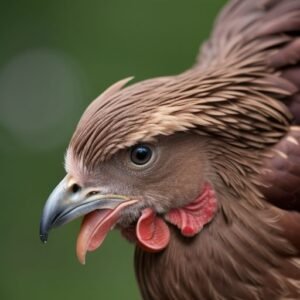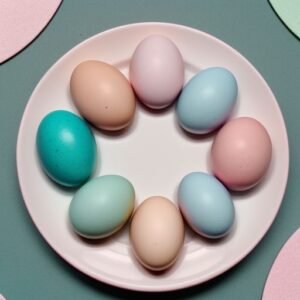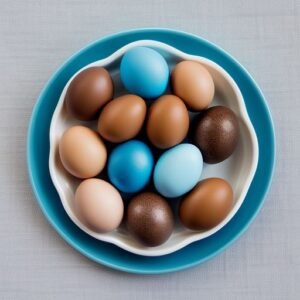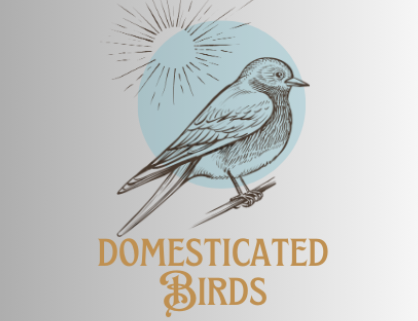Know everything about Chocolate easter eggers, their origin and history, appearance, pet traits, egg production, how to maintain egg production, owner suitability, benefits, and health risks.
Chocolate Easter Egger Origin and History
Place of Origin
The Chocolate Easter Egger chicken originated in the United States. It’s a modern breed, developed as part of the growing backyard poultry movement.
Year of Development
This variety of Easter Egger became popular in the late 20th to early 21st century.
Breeding History
Chocolate Easter Egger chickens are hybrids, often resulting from crossing Ameraucanas or Araucanas with brown egg-laying breeds. This crossbreeding results in chickens that lay a variety of egg colors, including the sought-after chocolate brown eggs.
Why It Was Named as Chocolate Easter Egger Chicken
The name “Chocolate Easter Egger” comes from two main features. “Chocolate” refers to the deep brown color of the eggs that some of these chickens lay. “Easter Egger” is a term for chickens that can lay eggs in various colors, similar to the variety of colors seen in Easter eggs.
Types of Easter Egger Breeds
Easter Eggers are not a true breed but a hybrid, resulting in a wide variety of appearances and egg colors. They are prized for their unique eggs, which can range from blue and green to pink and brown. This diversity makes them a popular choice for backyard flocks.
All Types of Easters Egger
- Blue Easter Egger
- Green Easter Egger
- Pink Easter Egger
- Olive Egger
- Chocolate Easter Egger
Chocolate Easter Egger Appearance
Chocolate Easter Egger Colors
These are known for their rich, chocolate-colored feathers. However, as hybrids, their coloration can vary significantly, including shades of brown, black, and even patterns like mottling or lacing.
Size and Weight
These chickens are medium-sized. Hens typically weigh between 4 to 5 pounds, while roosters can weigh between 5 to 6 pounds.
Shape
Chocolate Easter Eggers have a classic, sturdy chicken shape with a well-rounded body, prominent chest, and a slightly upright stance.
Comb and Wattles
They usually have a pea comb, which is small and less prone to frostbite. Their wattles are also relatively small, making them well-suited for colder climates.

Chocolate Easter Egger Chicken Characteristics
Chocolate Easter Egger Temperament
These are friendly and docile. They are curious birds that enjoy interacting with their human caretakers, making them great pets for families.
Foraging Ability
These chickens excel at foraging, making them ideal for free-range conditions. They love scratching and pecking for insects and seeds, which helps reduce your feed costs.
Hardiness
Chocolate Easter Eggers are hardy and adaptable to various climates. They have good resistance to common poultry diseases and are particularly suited for cold weather due to their small combs and wattles, which are less prone to frostbite.
Egg Laying
A standout feature of this is their ability to lay colorful eggs, including shades of blue, green, and brown. They typically begin laying eggs at around 5 to 6 months of age.
Chocolate Easter Egger Eggs
chocolate easter egger chicken Egg Colors
Chocolate Easter Egger eggs come in a variety of hues, from deep brown to shades of green, blue, and even pink.

chocolate easter egger egg production per year
Healthy hens typically lay around 4 to 5 eggs per week, totaling approximately 16 to 20 eggs per month. Annual production ranges from 200 to 280 eggs, though this can vary based on factors such as diet, environment, and overall health.
Unique Egg Quality
What distinguishes Chocolate Easter Egger eggs is their vibrant array of colors, ranging from rich browns to pastel blues and greens, adding visual appeal to any egg collection.
Adaptability to Different Climates
Chocolate Easter Eggers are adaptable to various climates, thriving in colder environments due to their physical adaptations such as small combs and wattles, while also performing well in warmer regions with proper care.
Know in detail about Egg-Laying chickens.
Things to Do to Maintain Chocolate Easter Egger Egg Production
Feed a Nutritious Diet
Keep your Chocolate Easter Eggers happy and laying by providing a well-rounded diet. Offer a mix of high-quality feed, fresh greens, and occasional treats like mealworms to keep them healthy and satisfied.
Complete chicken’s food in summer and winter.
Ensure Comfortable Living Conditions
Create a cozy and stress-free environment for your Chocolate Easter Eggers. Ensure they have enough space, proper ventilation, and clean nesting boxes to encourage regular egg laying.
Monitor Egg-Laying Habits
Keep an eye on your Chocolate Easter Eggers’ egg-laying patterns. If you notice a decrease in production, consider adjusting their diet, reducing stressors, or consulting with a vet for guidance.
Provide Adequate Lighting
Help stimulate egg production by providing consistent lighting (14 to 15 hours). Use artificial light to mimic natural daylight, especially during shorter days, to keep your hens laying throughout the year.
Collect Eggs Promptly
Make it a habit to collect Chocolate Easter Egger eggs daily. This not only keeps the eggs clean and prevents breakage but also encourages continued laying.
Maintain Their Health
Regularly check your Chocolate Easter Eggers for any signs of illness or discomfort. Keeping them healthy and happy is key to maintaining consistent egg production.
Ensure Calcium Availability
Support strong eggshell formation by providing calcium-rich supplements like oyster shell or crushed eggshells. This helps prevent issues with egg quality and production.
Minimize Stressors
Create a calm and peaceful environment for your Chocolate Easter Eggers. Minimize disturbances and avoid overcrowding to help them stay relaxed and productive.
Know about House setup for chicken, while reading about blue leghorn rooster.
Refresh Nesting Material Regularly
Keep their nesting boxes clean and comfortable by regularly replacing the bedding. A cozy nesting area encourages laying and ensures egg quality.
Hydrate Them Well
Provide fresh, clean water daily to keep your Chocolate Easter Eggers hydrated. Proper hydration is essential for egg production and overall well-being.
Seasonal Care Tips
During winter, provide additional warmth and protection from the cold. Especially in summer, offer shade and cool water to prevent heat stress and maintain egg production, as their physical appearance is mainly built for winter.

Owner’s Suitability
Suitable Owners
These Easter Eggers hens are ideal for:
Backyard chicken enthusiasts: If you love the idea of having a flock of chickens that lay eggs in a variety of beautiful colors, these Easter Eggers hens are perfect for you.
Families seeking friendly pets: These chickens have a gentle demeanor and enjoy interacting with their human companions, making them great additions to family homes.
Small-scale farmers: If you’re a small-scale farmer looking for reliable layers that can provide a colorful assortment of eggs, these Easter Eggers hens are an excellent choice.
Homesteaders valuing foragers: These Easter Eggers hens are skilled foragers, making them valuable additions to homesteads where self-sufficiency is prized.
Unsuitable Owners
Commercial egg producers: For commercial operations requiring uniform egg color and size, the varied egg colors of Chocolate Easter Eggers may not meet specific market demands.
Extreme hot climates: In regions with extremely hot temperatures and inadequate cooling measures, these Easter Eggers may struggle to maintain optimal health and egg production.
Expecting constant high egg production: While these Easter Eggers are prolific layers, they, like all chickens, experience natural fluctuations in egg production throughout the year. Owners expecting consistent high egg production year-round may be disappointed by seasonal variations.
Chocolate Easter Egger Health Risks
Common Health Issues: What Every Chicken Owner Should Know
- Mites and Lice: Check your flock regularly for signs of mites or lice. If you notice any, treat them promptly with poultry-safe products to keep your chickens comfortable and healthy.
- Respiratory Infections: Make sure their coop is well-ventilated to prevent respiratory issues. Good airflow helps keep their respiratory system healthy and reduces the risk of infections.
- Egg Binding: Help your hens avoid egg binding by feeding them a balanced diet rich in calcium. Strong eggshells are less likely to cause complications during egg-laying.
Specific Health Risks
- Frostbite: During cold weather, protect their combs and wattles from frostbite by providing adequate shelter and insulation in their coop. Keeping them warm and dry is key to preventing frostbite.
- Heat Stress: When temperatures soar, watch for signs of heat stress in your chickens. Offer plenty of shade, cool water, and even frozen treats to help them stay comfortable and cool.
- Parasitic Infections: To keep parasites at bay, stick to a regular deworming schedule and maintain cleanliness in their coop. Clean bedding and nesting boxes regularly to minimize the risk of parasitic infestations.
Chocolate Easter Egger chicken Benefits
Benefits for Enthusiasts
Colorful Eggs: Imagine the joy of collecting eggs in various hues, from rich chocolate brown to vibrant blue and green. It adds a delightful touch to your egg baskets and breakfast table.
Friendly Disposition: These chickens are more than just egg layers; they’re friendly and sociable creatures. Perfect for families or individuals looking for feathered companionship in their backyard.
Adaptability: Whether you live in a chilly northern climate or a sunny southern one, Chocolate Easter Eggers are adaptable birds. They’ll thrive in different environments, making them a versatile addition to your flock.
Benefits for Small Scale Farmers
Good Foragers: Watch your feed costs shrink as these natural foragers happily munch on bugs, seeds, and greens found in your yard. They’re efficient little foragers, which means less money spent on chicken feed.
Hardy Nature: Keep your vet visits to a minimum with Chocolate Easter Eggers’ robust health. They’re less prone to common poultry illnesses, saving you time and money on medical expenses.
Egg Production: Need a reliable source of fresh eggs? Look no further than Chocolate Easter Eggers. These ladies are consistent layers, providing you with a steady supply of eggs to enjoy or sell.
Conclusion
In wrapping up, it’s clear that Chocolate Easter Eggers bring a lot to the table, or rather, the coop! Their colorful eggs and friendly demeanor make them a hit with enthusiasts and small-scale farmers alike. Plus, their knack for foraging and resilience to diseases make them practical and cost-effective additions to any backyard or homestead. Whether you’re after beautiful eggs for breakfast or a reliable source of income, Chocolate Easter Eggers are hard to beat.
How to Recognize Easter Egger Chicken?
They are recognized by their varied feather colors, pea combs, and the colorful eggs they produce. Each bird can look quite different due to their hybrid nature.
How Easter Egger Chicken Was Bred?
Easter Eggers are typically bred by crossing Ameraucanas or Araucanas with other brown egg-laying breeds. This results in chickens that lay a variety of egg colors.
How Many Eggs Easter Egger Chicken Lay Per Year?
They can lay approximately 200 to 280 eggs annually, with variations depending on health, diet, and environment.
What Color of Eggs Easter Egger Chicken Lay?
Easter Eggers can lay eggs in a range of colors including blue, green, pink, and chocolate brown, making each egg collection a delightful surprise.
What is Chocolate Easter Egger Chicken?
The Chocolate Easter Egger chicken is a delightful hybrid breed known for its beautiful chocolate-colored or various other colored eggs and friendly nature. It is a versatile and hardy bird, well-suited for a variety of environments and owners.

